- CLASSIC MAGAZINES
- REVIEW CREW
A show recapping what critics thought back
when classic games first came out! - NEXT GENERATION'S BEST & WORST
From the worst 1-star reviews to the best
5-stars can offer, this is Next Generation! - NINTENDO POWER (ARCHIVE)
Experience a variety of shows looking at the
often baffling history of Nintendo Power! - MAGAZINE RETROSPECTIVE
We're looking at the absolutely true history of
some of the most iconic game magazines ever! - SUPER PLAY'S TOP 600
The longest and most ambitious Super NES
countdown on the internet! - THEY SAID WHAT?
Debunking predictions and gossip found
in classic video game magazines! - NEXT GENERATION UNCOVERED
Cyril is back in this spin-off series, featuring the
cover critic review the art of Next Generation! - HARDCORE GAMER MAGAZING (PDF ISSUES)
Download all 36 issues of Hardcore Gamer
Magazine and relive the fun in PDF form!
- REVIEW CREW
- ELECTRONIC GAMING MONTHLY
- ELECTRONIC GAMING MONTHLY RANKS
From Mario to Sonic to Street Fighter, EGM
ranks classic game franchises and consoles! - ELECTRONIC GAMING MONTHLY BEST & WORST
Counting down EGM’s best and worst reviews
going year by year, from 1989 – 2009! - ELECTRONIC GAMING BEST & WORST AWARDS
11-part video series chronicling the ups and
downs of EGM’s Best & Worst Awards!
- ELECTRONIC GAMING MONTHLY RANKS
- GAME HISTORY
- GAME OVER: STORY BREAKDOWNS
Long-running series breaking down game
stories and analyzing their endings! - A BRIEF HISTORY OF GAMING w/ [NAME HERE]
Real history presented in a fun and pithy
format from a variety of game historians! - THE BLACK SHEEP
A series looking back at the black sheep
entries in popular game franchises! - INSTANT EXPERT
Everything you could possibly want to know
about a wide variety of gaming topics! - FREEZE FRAME
When something familiar happens in the games
industry, we're there to take a picture! - I'VE GOT YOUR NUMBER
Learn real video game history through a series
of number-themed episodes, starting at zero! - GREAT MOMENTS IN BAD ACTING
A joyous celebration of some of gaming's
absolute worst voice acting!
- GAME OVER: STORY BREAKDOWNS
- POPULAR SHOWS
- DG NEWS w/ LORNE RISELEY
Newsman Lorne Riseley hosts a regular
series looking at the hottest gaming news! - REVIEW REWIND
Cyril replays a game he reviewed 10+ years
ago to see if he got it right or wrong! - ON-RUNNING FEUDS
Defunct Games' longest-running show, with
editorials, observations and other fun oddities! - DEFUNCT GAMES QUIZ (ARCHIVE)
From online quizzes to game shows, we're
putting your video game knowledge to the test!- QUIZ: ONLINE PASS
Take a weekly quiz to see how well you know
the news and current gaming events! - QUIZ: KNOW THE GAME
One-on-one quiz show where contestants
find out if they actually know classic games! - QUIZ: THE LEADERBOARD
Can you guess the game based on the classic
review? Find out with The Leaderboard!
- QUIZ: ONLINE PASS
- DEFUNCT GAMES VS.
Cyril and the Defunct Games staff isn't afraid
to choose their favorite games and more! - CYRIL READS WORLDS OF POWER
Defunct Games recreates classic game
novelizations through the audio book format!
- DG NEWS w/ LORNE RISELEY
- COMEDY
- GAME EXPECTANCY
How long will your favorite hero live? We crunch
the numbers in this series about dying! - VIDEO GAME ADVICE
Famous game characters answer real personal
advice questions with a humorous slant! - FAKE GAMES: GUERILLA SCRAPBOOK
A long-running series about fake games and
the people who love them (covers included)! - WORST GAME EVER
A contest that attempts to create the worst
video game ever made, complete with covers! - LEVEL 1 STORIES
Literature based on the first stages of some
of your favorite classic video games! - THE COVER CRITIC
One of Defunct Games' earliest shows, Cover
Critic digs up some of the worst box art ever! - COMMERCIAL BREAK
Take a trip through some of the best and
worst video game advertisements of all time! - COMIC BOOK MODS
You've never seen comics like this before.
A curious mix of rewritten video game comics!
- GAME EXPECTANCY
- SERIES ARCHIVE
- NINTENDO SWITCH ONLINE ARCHIVE
A regularly-updated list of every Nintendo
Switch Online release, plus links to review! - PLAYSTATION PLUS CLASSIC ARCHIVE
A comprehensive list of every PlayStation
Plus classic release, including links! - RETRO-BIT PUBLISHING ARCHIVE
A regularly-updated list of every Retro-Bit
game released! - REVIEW MARATHONS w/ ADAM WALLACE
Join critic Adam Wallace as he takes us on a
classic review marathon with different themes!- DEFUNCT GAMES GOLF CLUB
Adam Wallace takes to the links to slice his way
through 72 classic golf game reviews! - 007 IN PIXELS
Adam Wallace takes on the world's greatest spy
as he reviews 15 weeks of James Bond games! - A SALUTE TO VAMPIRES
Adam Wallace is sinking his teeth into a series
covering Castlevania, BloodRayne and more! - CAPCOM'S CURSE
Adam Wallace is celebrating 13 days of Halloween
with a line-up of Capcom's scariest games! - THE FALL OF SUPERMAN
Adam Wallace is a man of steel for playing
some of the absolute worst Superman games! - THE 31 GAMES OF HALLOWEEN
Adam Wallace spends every day of October afraid
as he reviews some of the scariest games ever! - 12 WEEKS OF STAR TREK
Adam Wallace boldly goes where no critic has
gone before in this Star Trek marathon!
- DEFUNCT GAMES GOLF CLUB
- DAYS OF CHRISTMAS (ARCHIVE)
Annual holiday series with themed-episodes
that date all the way back to 2001!- 2015: 30 Ridiculous Retro Rumors
- 2014: 29 Magazines of Christmas
- 2013: 29 Questionable Power-Ups of Christmas
- 2012: 34 Theme Songs of Christmas
- 2011: 32 Game Endings of Christmas
- 2010: 31 Bonus Levels of Christmas
- 2009: 30 Genres of Christmas
- 2008: 29 Controls of Christmas
- 2007: 34 Cliches of Christmas
- 2006: 33 Consoles of Christmas
- 2005: 32 Articles of Christmas
- 2004: 31 Websites of Christmas
- 2003: 29 Issues of Christmas
- 2002: 28 Years of Christmas
- 2001: 33 Days of Christmas
- NINTENDO SWITCH ONLINE ARCHIVE
- REVIEW ARCHIVE
- FULL ARCHIVE
The Rise and Abrupt Fall of E3

Part of me is really going to miss the memorable walk to the front of the Los Angeles Convention Center!
It's a proven fact: If you have a product to sell, the best way to do this is to make sure as many people as possible see it. For a very new video game industry, this was a particular challenge. The paths
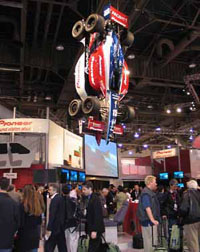
Along with video games, the CES of old featured car stereos, DVD players, digital radios, and dangerous hanging cars!
But while the Consumer Electronic Show felt like the perfect fit to many outside observers, in truth the video game industry was treated much like a second-class citizen. The video games

Did you know that the CES also plays host to a lot of adult video venders?
As the video game industry grew, both with computer games and consoles, it began to outgrow the tiny space provided for it by the Consumer Electronics Show. Despite the lack of recognition from CES, more and more attendees showed up to see what the video game companies were
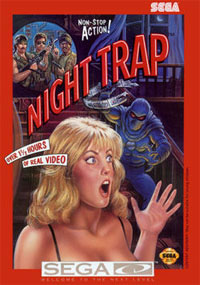
It's hard to believe but Night Trap had a hand in forming E3!
The idea was called E3, or the Electronic Entertainment Expo. Originally, not everyone was on board for the idea of E3. Some companies, such as Nintendo, wanted to have an additional version of
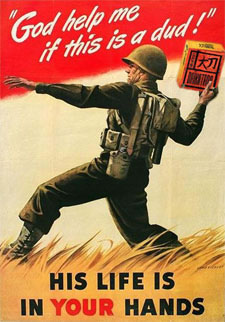
Okay, so Daikatana wasn't very good ... but you can't hold E3 responsible for every bad game that comes out!
The Sega Saturn, SNK's Neo-Geo CD, Sony PlayStation, Nintendo 64 (known at the time as the Ultra 64) and the Virtual Boy were all displayed, and the famous "$299!" speech for the PlayStation was delivered. It was a huge coup for the industry, and no one even thought about looking back at the CES. They had proven that they were an industry that was able to exist on its own without the support of the rest of the electronics industry, and from this first, relatively humble year, the event only grew. Future events would give us the Dreamcast, Duke Nukem
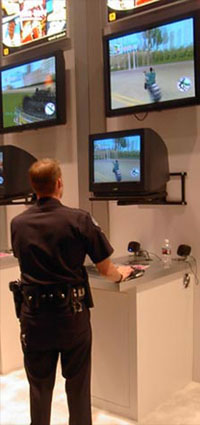
Regardless of where it was held, you could always find interesting things to take pictures of at E3 (like this cop playing Grand Theft Auto)!
For the first two years E3 was held at the Los Angeles Convention Center, a large facility that was split up into several different halls (such as the West Hall, South Hall, Kentia Hall, etc.). In 1997 E3 moved to Atlanta, Georgia, which was universally panned by the game companies showing off their products and the media outlets covering them. 40,000 people made the pilgrimage to Georgia only to find a cramped location that wasn't set up for an event like E3. Many complained about the heat, the narrow hallways, and the difficulty in transportation. Two years later E3 returned to the Los Angeles Convention Center, where it will remain until 2006.
Anyone who has been to an E3 in the past can tell you that it's an experience not easily replicated

Don't worry, they're used to it!
Beyond the admittance fee, which regularly fluctuated, there were certain things that a dedicated fan learned to expect. It's been estimated that in 2005 over 70,000 people crammed into E3. When you consider the size of the Los Angeles Convention Center this is an overwhelming amount of people. Sadly, our particular lot isn't known for a love of personal hygiene. Cramming 70,000 poorly washed people in a poorly ventilated convention center created an aroma that was almost certainly unique to E3. Some actually dubbed it the E3 Scent. Rest assured
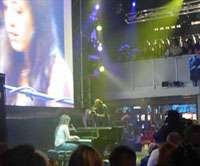
Yes, that's a concert going on in the Midway booth. Needless to say, E3 was very, very loud!
There was far more to E3 than just the mainstream exhibitors, though. The IDSA remembered the exclusive nature of the games industry in the beginning, and opened an area of the convention center for those oddball or experimental creations that wouldn't

Guitar Hero was originally found in Kentia Hall. The girl we found on Hollywood Blvd!
Sadly, though, there will be no more Kentia Hall. The Electronic Entertainment Expo was more successful than hoped, which ultimately killed what we knew up until now. Even though tens of thousands of people looked forward to attending E3 each year, the show had become too much of a circus to actually get any work done. Too many non-industry players were finding ways of getting in, ultimately forcing the various companies (from

The problem with the E3 of old is that too many people who didn't belong there ended up finding ways in!
So the ESA did the unthinkable: They downsized E3 and turned it into the E3 Media & Business Summit. Instead of being held in May, the new miniaturized and refocused E3 is being presented in July. Instead of 75,000 guests, there will be between three and four thousand. Where it had once expanded into a weeklong event (with conferences and parties), it's now being compressed back down into three days. The desire is to focus on conducting business instead of entertaining the crowds, and there is certainly an
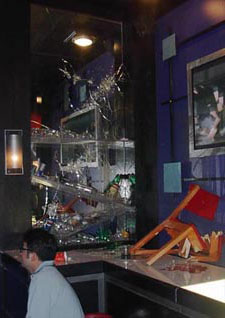
With so many visitors filing through the booths it's easy to understand how things could get damanged and beaten up!
Also, technology out-paced the original goal of E3. Demos of games can now be distributed digitally to millions of users. Trailers are released almost daily across the internet, and the press coverage for video games has never been more inclusive than it is now. I am saddened to see the death of E3 as we knew it, but there are other options, certainly. Penny Arcade Expo, for example, is looking to pick up the slack of a yearly expo, along with the ESA's Entertainment for All expo (held at the old E3 location), which seeks to move beyond the strict limitations of the original E3. Video game art galleries, concerts, and other entertainment will be made available at E for All, which will run for the first time this October.
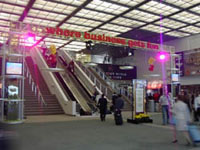
I don't know what the future of E3 holds for us, but I do know that it's not up those stairs!
Maybe the original purpose of E3 is no longer needed, and it's right for the idea to be retired. Maybe it is still needed and another option will be born to continue its work. Will this be the final E3 as some have suggested? Who knows? Cyril, Keeper of the Light for this site, might have some unique insights when he returns from the first mini E3 (MinE-3?). Until then, we'll just wait and see what becomes history.

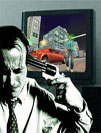


HOME |
CONTACT |
NOW HIRING |
WHAT IS DEFUNCT GAMES? |
NINTENDO SWITCH ONLINE |
RETRO-BIT PUBLISHING
Retro-Bit |
Switch Planet |
The Halcyon Show |
Same Name, Different Game |
Dragnix |
Press the Buttons
Game Zone Online | Hardcore Gamer | The Dreamcast Junkyard | Video Game Blogger
Dr Strife | Games For Lunch | Mondo Cool Cast | Boxed Pixels | Sega CD Universe | Gaming Trend
Game Zone Online | Hardcore Gamer | The Dreamcast Junkyard | Video Game Blogger
Dr Strife | Games For Lunch | Mondo Cool Cast | Boxed Pixels | Sega CD Universe | Gaming Trend
Copyright © 2001-2025 Defunct Games
All rights reserved. All trademarks are properties of their respective owners.
All rights reserved. All trademarks are properties of their respective owners.
























